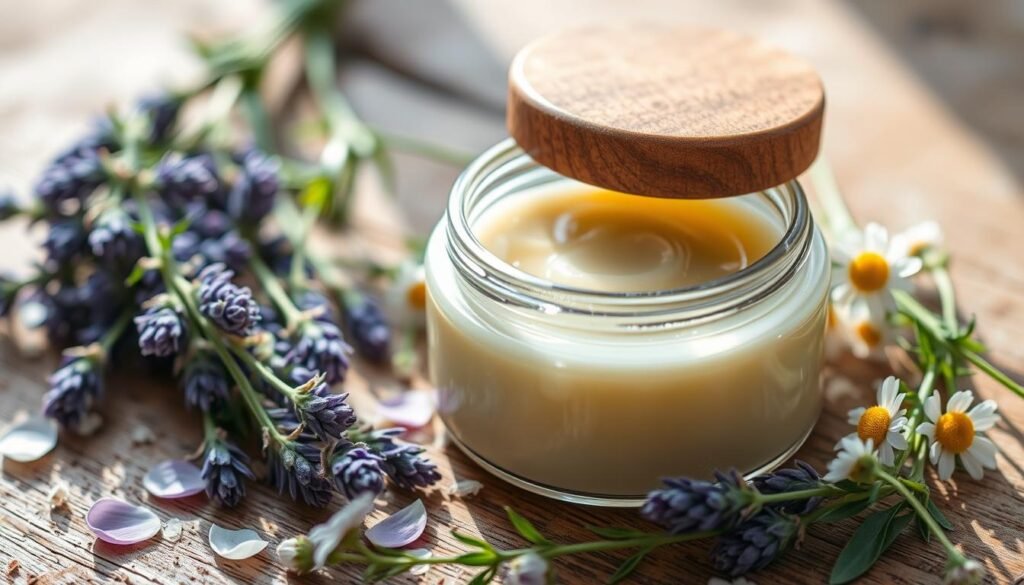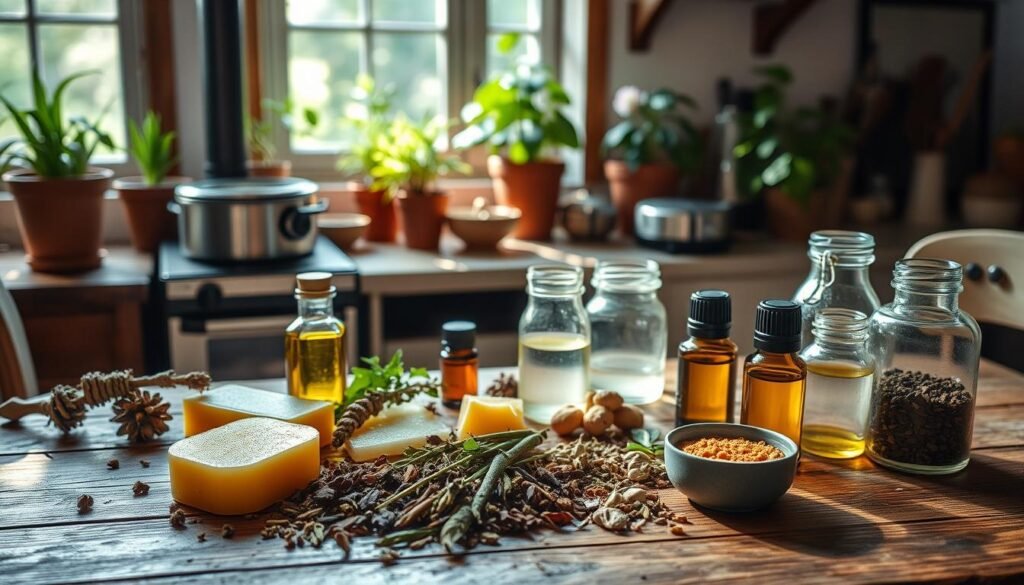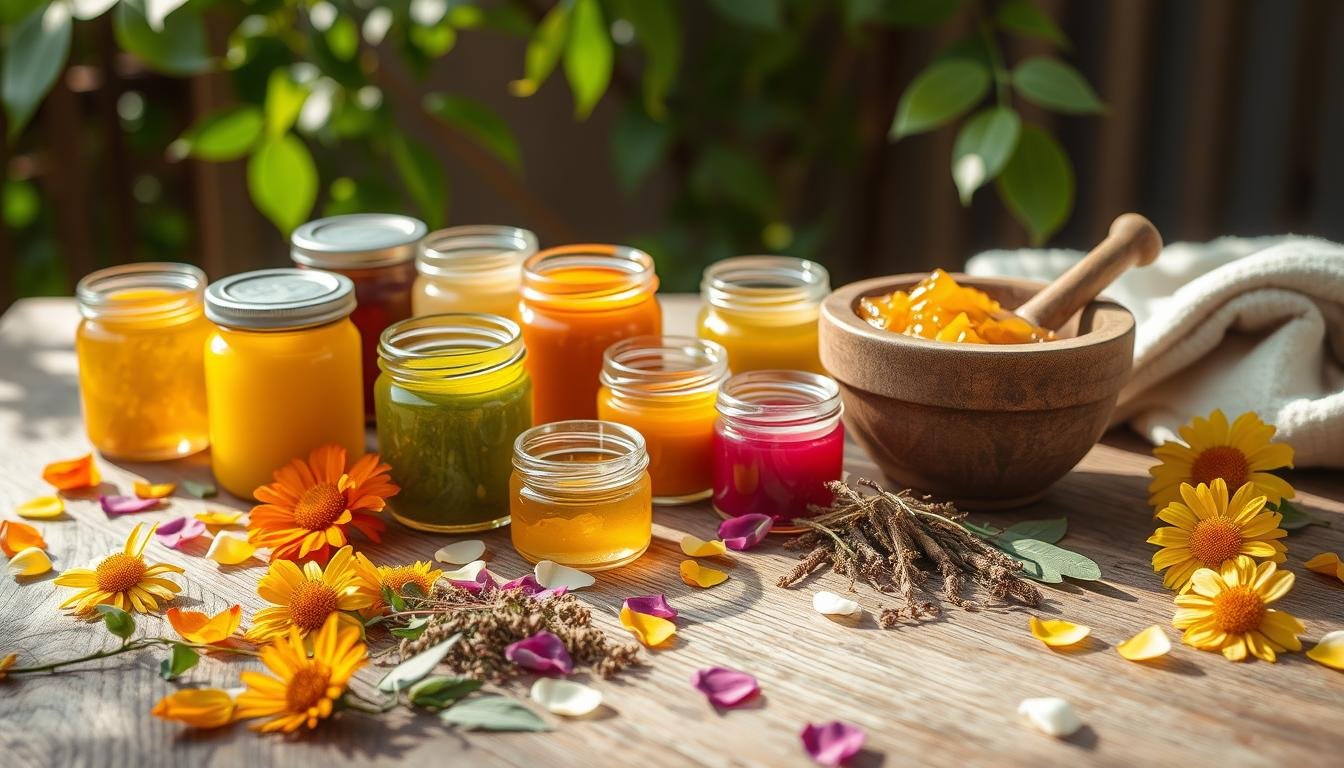Did you know a single jar of premium salve can have over 50 plant-based ingredients? Each one is chosen for its healing powers. Salves are key in natural skincare, mixing botanical extracts, essential oils, and fats to heal and protect the skin. They help with dry patches and soothe irritated areas, making them a long-standing part of traditional medicine.

In this guide, we’ll dive into the amazing healing powers of salve. It’s a must-have for natural wellness. Whether you need relief from aches, have skin issues, or want to nourish your body, salve can help. Get ready to see how this ancient remedy can transform your skin, increase comfort, and boost your overall health.
Key Takeaways
- Salves are solid, oil-based herbal treatments that provide natural healing and nourishment for the skin
- They are made with a blend of pure essential oils, natural butters, and nourishing oils to address a variety of skin concerns
- Salves create a protective barrier on the skin, allowing for deeper penetration of ingredients and long-lasting hydration
- Celestial Sage is a brand that offers a range of high-quality, handcrafted herbal salves for diverse therapeutic purposes
- Salves have been used in traditional medicine for centuries, with some historic formulations still available today
Understanding Natural Salves and Their Healing Properties
Salves have been used for centuries as natural remedies. They use plants to help with many health issues. These treatments mix herbs, oils, and beeswax to heal.
Traditional Uses Throughout History
Salves were seen as cure-alls for a long time. In America, from the mid-nineteenth to early twentieth century, they were used for skin problems and minor injuries. This shows the long-standing belief in natural healing.
The Science Behind Salve Effectiveness
Salves work by protecting the skin and delivering plant compounds. This helps to nourish and heal the skin. The mix of base oils, beeswax, and herbs is key to their effectiveness.
Key Components of Natural Salves
- Base oils: Such as coconut, sunflower, or olive oil, which provide a nourishing foundation for the salve.
- Beeswax: Adds structure and helps to create a protective barrier on the skin.
- Therapeutic herbs: Carefully selected for their specific healing properties, such as calendula for rashes, comfrey for minor wounds, and plantain for bug bites and scrapes.
Learning about salves’ history, science, and ingredients helps us use them to improve our health.
Benefits of Salve for Various Health Conditions
Salves are a natural way to tackle many health issues. They are made from plants and have special properties. These can help with skin problems, minor burns, and even muscle pain.
Salves are great for soothing and protecting the skin. They work well on dry, chapped skin, like eczema. Ingredients like beeswax and oils keep moisture in and shield the skin.
For those who are always on the move, salves are a big help. Squirrel’s Nut Butter Cycling Salve is perfect for athletes. It prevents skin issues and works in any weather.
Salves can also ease muscle aches and pains. Ingredients like CBD can help with pain. Using a salve with 300-500 mg of CBD per ounce is a gentle way to find relief.
Looking into salves for skin issues, pain, or wellness is a good idea. Knowing what’s in them and how they work can help you find the right one. This way, you can enjoy their benefits.
Essential Ingredients in Natural Healing Salves
Creating effective natural healing salves requires careful ingredient selection. Each part, from base oils to therapeutic herbs, is crucial. They work together to enhance the salve’s healing power. Let’s explore the key ingredients that make natural salves great for skin health and wound care.
Common Base Oils and Their Properties
The base oil is the salve’s foundation. Oils like olive, almond, and jojoba are chosen for their skin benefits. They moisturize and protect the skin, providing essential fatty acids and vitamins.
The right mix of beeswax and oil is important. A 1:3 to 1:5 ratio is common. It gives the salve the right texture and firmness.
Therapeutic Herbs and Their Effects
Infused herbs add magic to natural salves. Plants like calendula, comfrey, and chamomile are chosen for their healing powers. They help with inflammation, wound healing, and skin irritation.
The Role of Beeswax in Salve Making
Beeswax is a key ingredient in salves. It solidifies the salve and protects the skin. Its antimicrobial and nourishing properties are vital. Adjusting the beeswax to oil ratio changes the salve’s texture.
| Ingredient | Properties and Benefits |
|---|---|
| Olive Oil | Moisturizing, anti-inflammatory, and high in antioxidants |
| Almond Oil | Gentle, nourishing, and high in vitamin E |
| Jojoba Oil | Closely resembles the skin’s natural oils, deeply hydrating |
| Beeswax | Creates a protective barrier, antimicrobial, and soothing |
| Calendula | Anti-inflammatory, wound-healing, and skin-regenerating |
| Comfrey | Promotes tissue repair, reduces inflammation, and soothes skin |
| Chamomile | Calming, anti-inflammatory, and great for sensitive skin |
Understanding the ingredients in natural healing salves unlocks their full potential. They offer relief for dry skin and support for wound healing. The right mix of base oils, herbs, and beeswax makes a big difference.
Different Types of Healing Salves and Their Applications
Healing salves come in many forms, each for different skin needs. They range from ointments for scrapes and burns to face creams. The variety is vast and impressive.
First aid salves are popular for minor injuries. They have ingredients like comfrey and calendula to help wounds heal. These salves protect the skin and aid in its natural repair.
Rash creams are great for skin irritations or rashes. They use calming herbs like chamomile and plantain. These salves gently care for and balance the skin.
Salves also shine in facial care. Skin care salves with yarrow and calendula tackle many issues, from blemishes to aging signs. They leave the skin soft and refreshed.
Brands like Mentholatum, Bag Balm, and White Cloverine are well-known for their salve applications. They offer reliable solutions for skin care.
“The process of making salves provides an opportunity to discover and utilize local herbs and flowers for healing purposes.”
Looking to soothe a scrape, nourish your face, or tackle a skin issue? Healing salves are a great choice. They add value to any natural wellness routine.
How to Choose the Right Salve for Your Needs
Salves have been trusted for centuries in natural healing. They soothe and restore the skin and body. But, with so many options, picking the right one can be hard. We’ll look at what to consider when choosing a salve for your health.
Understanding Product Labels
Start by checking the product label. Look for natural, organic, or local ingredients. These are signs of quality. Stay away from synthetic fragrances and preservatives.
Read the ingredient list carefully. It tells you what’s in the salve and its benefits.
Quality Indicators to Look For
- Organic or natural ingredients
- Locally sourced or sustainably produced components
- Absence of synthetic fragrances, preservatives, and other additives
- Transparent and comprehensive ingredient list
Storage and Shelf Life Considerations
Storage and shelf life are key when picking a salve. Salves don’t have water, so they last longer than water-based products. But, the exact shelf life depends on the ingredients.
Salves usually last 6 months to 3 years in a cool, dark place. Always check the expiration date and follow storage tips for a fresh salve.
| Salve Shelf Life | Typical Shelf Life Range |
|---|---|
| Minimum Shelf Life | 6 months |
| Maximum Shelf Life | 3 years |
By looking at labels, quality, and storage, you can pick the best salve for you. This ensures a safe and effective natural remedy.
Making Your Own Natural Healing Salve at Home
Creating homemade salve recipes is a rewarding and empowering way to explore natural healing. By infusing oils with therapeutic herbs and adding beeswax, we can make our own DIY salves. These salves can help with specific skin conditions and wellness needs.
The salve-making process is simple. First, we choose dried herbs like calendula, comfrey, and lavender for their benefits. These herbs are infused into a carrier oil, such as olive or coconut oil, using cold or hot infusion.
After the herbal oil infusion is ready, we melt beeswax and mix it with the infused oil. The amount of beeswax to oil decides the salve’s texture. More wax makes it firmer, while less makes it softer.
We can also add essential oils like tea tree or rosemary to enhance the salve’s healing. These oils add extra skin-soothing and antimicrobial benefits.
The homemade healing salve lasts up to two years in a cool, dry place. It’s a cost-effective and long-lasting remedy for many skin issues, from cuts and bruises to diaper rash and poison ivy.
By making our own natural salves, we control the ingredients and can tailor them to our needs. It’s a fulfilling process that lets us harness the power of plants for our skin and well-being.

We encourage you to try homemade salve recipes and enjoy DIY salve making. Share your experiences and favorite recipes with us. We’d love to hear about your natural healing journey!
Comparing Salves to Other Topical Treatments
Salves are a top choice for natural healing. They are oil-based, unlike creams and lotions, which mix oils with water. This makes salves more effective at protecting the skin and delivering healing ingredients.
Salves vs. Creams and Lotions
Salves and creams or lotions are different in texture and ingredients. Salves are thicker and more balm-like. This is because they have more oils and waxes, creating a strong barrier on the skin.
Benefits Over Traditional Medications
Salves are a natural and gentle option compared to traditional medicines. They use nourishing oils and herbs to soothe and heal the skin. This makes them a great choice for those looking for a natural solution to skin problems.
The oil-based nature of salves helps them absorb better into the skin. This ensures the skin gets the most benefit from the active ingredients. It’s especially good for skin issues that need a strong and lasting treatment.
| Characteristic | Salves | Creams and Lotions |
|---|---|---|
| Consistency | Thicker, more balm-like | Lighter, more easily absorbed |
| Main Ingredients | Oils and waxes | Oils and water |
| Absorption Rate | Slower, more occlusive | Faster, less occlusive |
| Therapeutic Potential | Higher concentration of active ingredients | Lower concentration of active ingredients |
| Natural Approach | Often contain a blend of nourishing oils and herbs | May contain synthetic ingredients and preservatives |
Knowing the benefits of salves helps people choose the best natural treatments for their skin. This can lead to better skin health and overall well-being.
Safety Considerations and Best Practices
Using natural salves safely is key. Always do a patch test first. This is because some people might react to certain ingredients.
Keeping things clean is also important. This is especially true when using salves on wounds or sore skin. It helps avoid making things worse.
Don’t forget about the shelf life of your salves. Store them right to keep them working well. If you have serious burns or ongoing skin issues, talk to a doctor first. Natural salves are great, but they’re not a substitute for medical help.
By following these tips, we can use natural salves safely and effectively. This way, we get the most out of them while staying safe. A little caution can go a long way in using these natural remedies wisely.
FAQ
What are the benefits of using salves for natural healing?
Salves are herbal treatments for the skin. They help with pain, itching, and dryness. They seal the skin and let it absorb nutrients.
How have salves been used historically in traditional medicine?
Salves have been used for centuries in folk medicine. They were popular in America from the 1800s to the early 1900s. People used them to treat many ailments.
What are the key components of natural healing salves?
Salves have base oils, beeswax, and herbs. They protect the skin and deliver plant benefits.
What types of health conditions can salves be beneficial for?
Salves help with skin issues, minor burns, scrapes, bites, and muscle aches. They have antimicrobial and anti-inflammatory properties.
What are the common ingredients in natural healing salves?
Ingredients include oils like olive or almond, beeswax, and herbs like calendula and chamomile. Beeswax makes the salve solid and protects the skin.
What are the different types of healing salves and their applications?
There are many types of salves. Some are for scrapes and burns, others for rashes or face care. Ingredients vary based on the use, like comfrey for wounds or yarrow for the face.
How can I choose the right salve for my needs?
Choose based on the use and ingredients. Look for organic or local ingredients. Reading labels helps pick the right one. Store in a cool, dark place to keep it fresh.
How can I make my own natural healing salve at home?
Making salves at home involves infusing herbs in oil and mixing with beeswax. Choose herbs, infuse them in oil, then mix with melted beeswax. Add essential oils for extra benefits.
How do salves differ from creams and lotions?
Salves are oil-based and more occlusive than creams and lotions. They offer a natural treatment for skin issues. They are a gentle alternative to traditional medicines.
What safety considerations should I keep in mind when using salves?
Always do a patch test for allergies. Keep the application area clean. Know your salve’s shelf life and store it right. For serious issues, consult a doctor before using salves.
